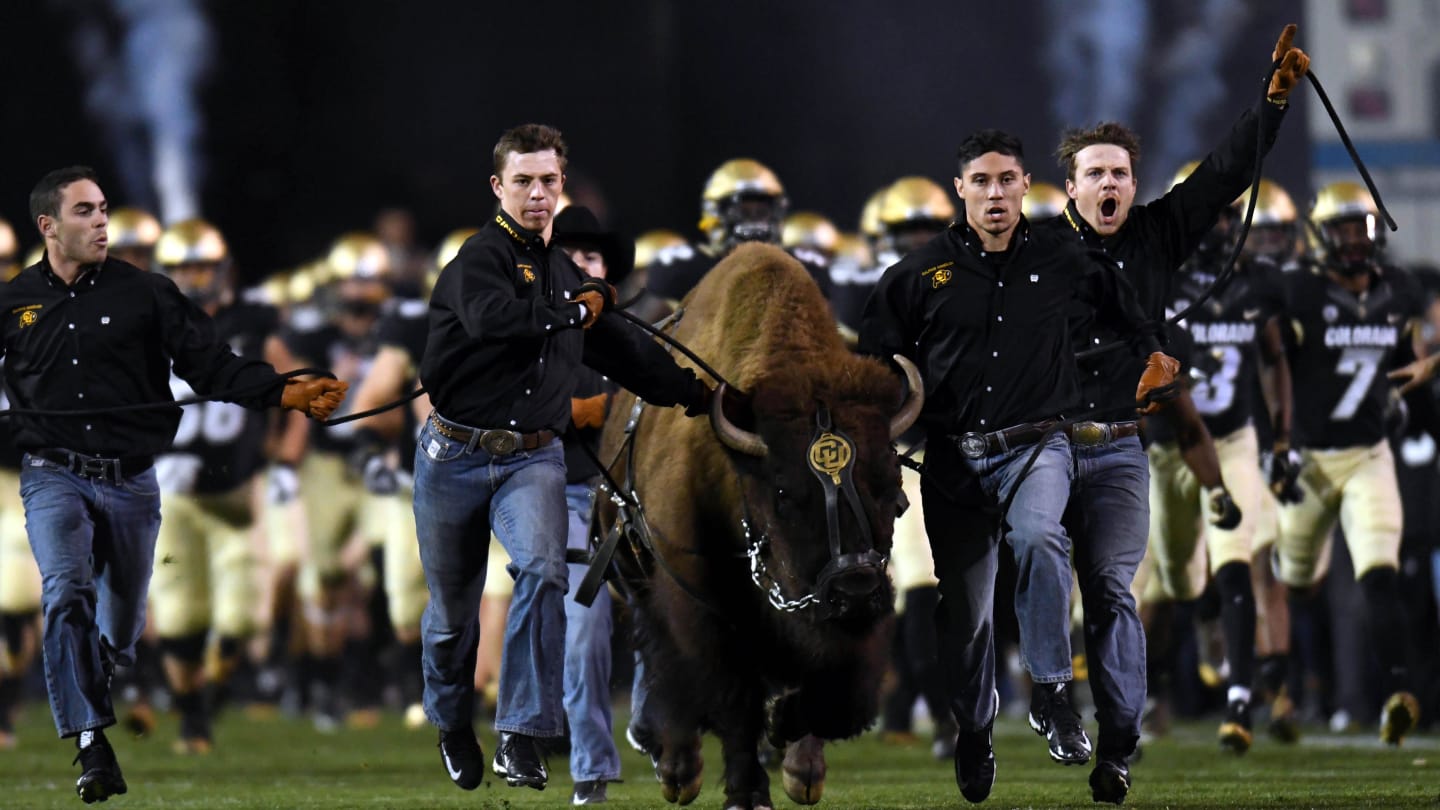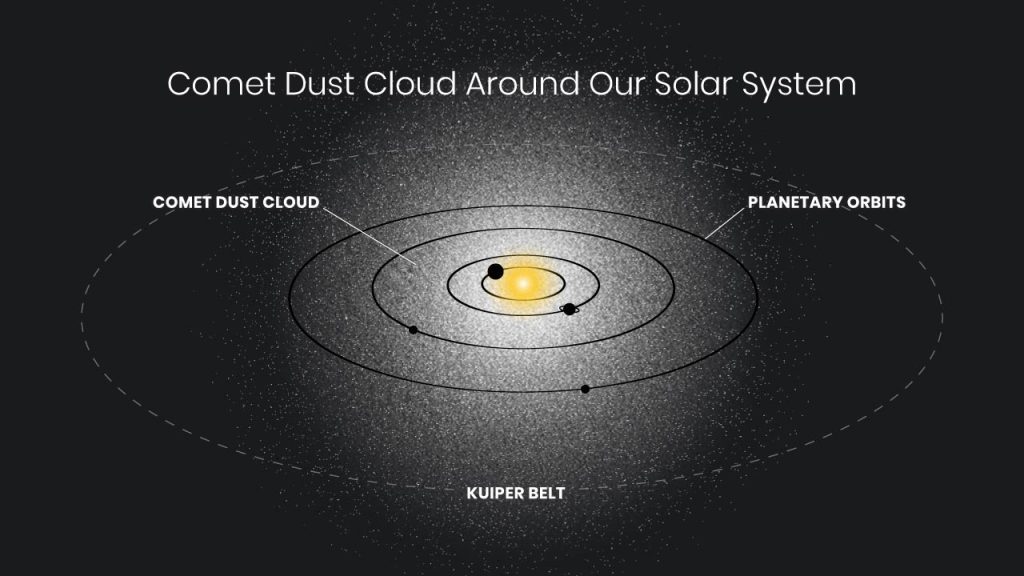
Die Illustration dieses Künstlers zeigt den Ort und die Größe einer hypothetischen Staubwolke, die unser Sonnensystem umgibt. Bildnachweis: NASA, ESA und Andi James (STScI)
Die Abgase lodernder Kometen machen den Weltraum zu einem staubigen Ort
Stellen Sie sich vor, Sie betreten nachts einen Raum, schalten alle Lichter aus und schließen die Vorhänge. Allerdings kommt ein seltsames Leuchten von den Wänden, der Decke und dem Boden. Das Licht ist schwach, kaum genug, um deine Hände vor deinem Gesicht zu sehen, aber es geht weiter.
Klingt wie eine Szene aus „Ghost Hunters“? Nein, das ist das einzig Wahre für Astronomen. Es ist jedoch nicht einfach, nach etwas zu suchen, das dem Nichts nahe kommt. Astronomen durchsuchten 200.000 Archivbilder Hubble-Weltraumteleskop Zehntausende von Messungen wurden von diesen Bildern durchgeführt, um nach verbleibendem Hintergrundglühen am Himmel zu suchen. Als würden sie das Licht in einem Raum ausschalten, subtrahierten sie das Licht von den Sternen, Galaxien, Planeten und sogar dem Tierkreislicht. (Das Tierkreislicht ist das schwache Leuchten von diffusem Sonnenlicht, das von interplanetarem Staub gestreut wird.) Überraschenderweise blieb ein schwaches gespenstisches Leuchten zurück. Es entspricht dem stetigen Licht von zehn Glühwürmchen, die über den Himmel verstreut sind.
Woher kommt das?
Eine mögliche Erklärung ist, dass eine Staubhülle unser Sonnensystem vollständig umhüllt[{“ attribute=““>Pluto, and is reflecting sunlight. Seeing airborne dust caught in sunbeams is no surprise when cleaning the house. But this must have a more exotic origin. Because the glow is so smoothy distributed, the likely source is innumerable comets – free-flying dusty snowballs of ice. They fall in toward the Sun from all different directions, spewing out an exhaust of dust as the ices sublimate due to heat from the Sun. If real, this would be a newly discovered architectural element of the solar system. It has remained invisible until very imaginative and curious astronomers, and the power of Hubble, came along.

This artist’s illustration shows the location and size of a hypothetical cloud of dust surrounding our solar system. Astronomers searched through 200,000 images and made tens of thousands of measurements from Hubble Space Telescope to discover a residual background glow in the sky. Because the glow is so smoothly distributed, the likely source is innumerable comets – free-flying dusty snowballs of ice. They fall in toward the Sun from all different directions, spewing out an exhaust of dust as the ices sublimate due to heat from the Sun. If real, this would be a newly discovered architectural element of the solar system. Credit: NASA, ESA, Andi James (STScI)
Hubble Space Telescope Detects Ghostly Glow Surrounding Our Solar System
Aside from a tapestry of glittering stars, and the glow of the waxing and waning Moon, the nighttime sky looks inky black to the casual observer. But how dark is dark?
To find out, astronomers decided to sort through 200,000 images from NASA’s Hubble Space Telescope and made tens of thousands of measurements on these images to look for any residual background glow in the sky, in an ambitious project called SKYSURF. This would be any leftover light after subtracting the glow from planets, stars, galaxies, and from dust in the plane of our solar system (called zodiacal light).
When researchers completed this inventory, they found an exceedingly tiny excess of light, equivalent to the steady glow of 10 fireflies spread across the entire sky. That’s like turning out all the lights in a shuttered room and still finding an eerie glow coming from the walls, ceiling, and floor.

This photo shows the zodiacal light as it appeared on March 1, 2021, in Skull Valley, Utah. The Pleiades star cluster is visible near the top of the light column. Mars is just below that. Credit: NASA/Bill Dunford
The researchers say that one possible explanation for this residual glow is that our inner solar system contains a tenuous sphere of dust from comets that are falling into the solar system from all directions, and that the glow is sunlight reflecting off this dust. If real, this dust shell could be a new addition to the known architecture of the solar system.
This idea is bolstered by the fact that in 2021 another team of astronomers used data from NASA’s New Horizons spacecraft to also measure the sky background. New Horizons flew by Pluto in 2015, and a small Kuiper belt object in 2018, and is now heading into interstellar space. The New Horizons measurements were done at a distance of 4 billion to 5 billion miles from the Sun. This is well outside the realm of the planets and asteroids where there is no contamination from interplanetary dust.
New Horizons detected something a bit fainter that is apparently from a more distant source than Hubble detected. The source of the background light seen by New Horizons also remains unexplained. There are numerous theories ranging from the decay of dark matter to a huge unseen population of remote galaxies.
“If our analysis is correct there’s another dust component between us and the distance where New Horizons made measurements. That means this is some kind of extra light coming from inside our solar system,” said Tim Carleton, of Arizona State University (ASU).
“Because our measurement of residual light is higher than New Horizons we think it is a local phenomenon that is not from far outside the solar system. It may be a new element to the contents of the solar system that has been hypothesized but not quantitatively measured until now,” said Carleton.
Hubble veteran astronomer Rogier Windhorst, also of ASU, first got the idea to assemble Hubble data to go looking for any “ghost light.” “More than 95% of the photons in the images from Hubble’s archive come from distances less than 3 billion miles from Earth. Since Hubble’s very early days, most Hubble users have discarded these sky-photons, as they are interested in the faint discrete objects in Hubble’s images such as stars and galaxies,” said Windhorst. “But these sky-photons contain important information which can be extracted thanks to Hubble’s unique ability to measure faint brightness levels to high precision over its three decades of lifetime.”
A number of graduate and undergraduate students contributed to project SKYSURF, including Rosalia O’Brien, Delondrae Carter and Darby Kramer at ASU, Scott Tompkins at the University of Western Australia, Sarah Caddy at Macquarie University in Australia, and many others.
The team’s research papers are published in The Astronomical Journal and The Astrophysical Journal Letters.
References:
“SKYSURF: Constraints on Zodiacal Light and Extragalactic Background Light through Panchromatic HST All-sky Surface-brightness Measurements: II. First Limits on Diffuse Light at 1.25, 1.4, and 1.6 µm” by Timothy Carleton, Rogier A. Windhorst, Rosalia O’Brien, Seth H. Cohen, Delondrae Carter, Rolf Jansen, Scott Tompkins, Richard G. Arendt, Sarah Caddy, Norman Grogin, Scott J. Kenyon, Anton Koekemoer, John MacKenty, Stefano Casertano, Luke J. M. Davies, Simon P. Driver, Eli Dwek, Alexander Kashlinsky, Nathan Miles, Nor Pirzkal, Aaron Robotham, Russell Ryan, Haley Abate, Hanga Andras-Letanovszky, Jessica Berkheimer, Zak Goisman, Daniel Henningsen, Darby Kramer, Ci’mone Rogers and Andi Swirbul, 4 October 2022, The Astronomical Journal.
DOI: 10.3847/1538-3881/ac8d02
“SKYSURF: Constraints on Zodiacal Light and Extragalactic Background Light through Panchromatic HST All-sky Surface-brightness Measurements. I. Survey Overview and Methods” by Rogier A. Windhorst, Timothy Carleton, Rosalia O’Brien, Seth H. Cohen, Delondrae Carter, Rolf Jansen, Scott Tompkins, Richard G. Arendt, Sarah Caddy, Norman Grogin, Anton Koekemoer, John MacKenty, Stefano Casertano, Luke J. M. Davies, Simon P. Driver, Eli Dwek, Alexander Kashlinsky, Scott J. Kenyon, Nathan Miles, Nor Pirzkal, Aaron Robotham, Russell Ryan, Haley Abate, Hanga Andras-Letanovszky, Jessica Berkheimer, John Chambers, Connor Gelb, Zak Goisman, Daniel Henningsen, Isabela Huckabee, Darby Kramer, Teerthal Patel, Rushabh Pawnikar, Ewan Pringle, Ci’mone Rogers, Steven Sherman, Andi Swirbul and Kaitlin Webber, 15 September 2022, The Astronomical Journal.
DOI: 10.3847/1538-3881/ac82af
“SKYSURF-3: Testing Crowded Object Catalogs in the Hubble eXtreme Deep Field Mosaics to Study Sample Incompleteness from an Extragalactic Background Light Perspective” by Darby M. Kramer, Timothy Carleton, Seth. H. Cohen, Rolf Jansen, Rogier A. Windhorst, Norman Grogin, Anton Koekemoer, John W. MacKenty and Nor Pirzkal, 18 November 2022, The Astronomical Journal Letters.
DOI: 10.3847/2041-8213/ac9cca
“SKYSURF-4: Panchromatic Full Sky Surface Brightness Measurement Methods and Results” by Rosalia O’Brien, Timothy Carleton, Rogier A. Windhorst, Rolf A. Jansen, Delondrae Carter, Scott Tompkins, Sarah Caddy, Seth H. Cohen, Haley Abate, Richard G. Arendt, Jessica Berkheimer, Annalisa Calamida, Stefano Casertano, Simon P. Driver, Connor Gelb, Zak Goisman, Norman Grogin, Daniel Henningsen, Isabela Huckabee, Scott J. Kenyon, Anton M. Koekemoer, Darby Kramer, John Mackenty, Aaron Robotham and Steven Sherman, 13 October 2022, Astrophysics > Instrumentation and Methods for Astrophysics.
arXiv:2210.08010
The Hubble Space Telescope is a project of international cooperation between NASA and ESA. NASA’s Goddard Space Flight Center in Greenbelt, Maryland, manages the telescope. The Space Telescope Science Institute (STScI) in Baltimore, Maryland, conducts Hubble and Webb science operations. STScI is operated for NASA by the Association of Universities for Research in Astronomy, in Washington, D.C.

„Entdecker. Entschuldigungsloser Unternehmer. Alkoholfanatiker. Zertifizierter Schriftsteller. Möchtegern-TV-Evangelist. Twitter-Fanatiker. Student. Webwissenschaftler.






More Stories
Die NASA macht in Bezug auf die Erde eine Entdeckung, die „so wichtig wie die Schwerkraft“ ist
Wie wurden Schwarze Löcher so groß und schnell? Die Antwort liegt im Dunkeln
Eine Studentin der University of North Carolina wird die jüngste Frau sein, die an Bord von Blue Origin die Grenzen des Weltraums überschreitet